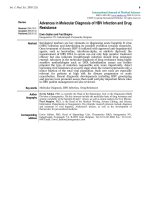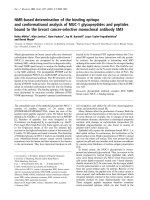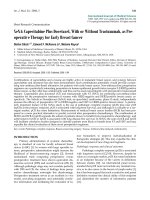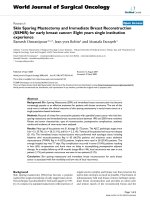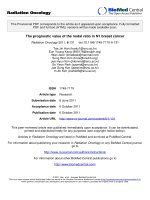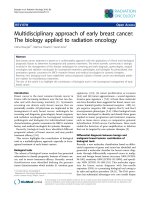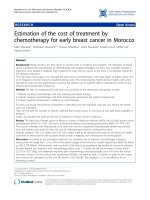Báo cáo y học: " the Value of Serum Biomarkers (Bc1, Bc2, Bc3) in the Diagnosis of Early Breast Cancer"
Bạn đang xem bản rút gọn của tài liệu. Xem và tải ngay bản đầy đủ của tài liệu tại đây (449.17 KB, 8 trang )
Int. J. Med. Sci. 2011, 8
148
I
I
n
n
t
t
e
e
r
r
n
n
a
a
t
t
i
i
o
o
n
n
a
a
l
l
J
J
o
o
u
u
r
r
n
n
a
a
l
l
o
o
f
f
M
M
e
e
d
d
i
i
c
c
a
a
l
l
S
S
c
c
i
i
e
e
n
n
c
c
e
e
s
s
2011; 8(2):148-155
© Ivyspring International Publisher. All rights reserved.
Research Paper
The Value of Serum Biomarkers (Bc1, Bc2, Bc3) in the Diagnosis of Early
Breast Cancer
Kemal Atahan
1
, Hakan Küpeli
1
, Serhat Gür
1
, Türkan Yiğitbaşı
2
, Yasemin Baskın
3
, Seyran Yiğit
4
, Mehmet
Deniz
1
, Atilla Çökmez
1
, Ercüment Tarcan
1
1. İzmir Atatürk Training and Research Hospital 1st Surgical Clinic
2. İzmir Atatürk Training and Research Hospital 1st Biochemistry Clinic
3. Dokuz Eylül University Institute of Oncology
4. İzmir Atatürk Training and Research Hospital 1st Pathology Clinic
Corresponding author: Kemal Atahan, 6342 sok. No:44 Ayşe Kaya 2 Apt. Kat:3, Daire:6 35540 Bostanlı/İzmir/TURKEY.
Phone: +905324126805; Fax: +902322445624 ; e-mail:
Received: 2010.11.10; Accepted: 2011.01.31; Published: 2011.02.12
Abstract
Background: Surface enhanced laser desorption/ionization time-of-flight mass spectrometry
(SELDI-TOF) is an approach to biomarker discovery that combines chromatography and mass
spectrometry. We aimed to consider the efficacy of Bc1, Bc2, and Bc3 serum biomarkers on
early detection of breast cancer (BC) in this study.
Study Design: In this prospective study, 91 patients who were admitted to our hospital
between January 2007 and July 2008 were included. Serum samples from 91 women were
stored at -80 °C until use. The cancer group included 27 cases of BC. The benign breast
disease group included 24 women with benign breast diseases and control group 37
age-matched apparently healthy women. The data obtained for these three groups of patients
was worked out for each serum biomarker (Bc1, Bc2, and Bc3) by using SELDI-TOF indi-
vidually and compared with each other separately and evaluated statistically.
Results: Bc2 possesses the highest individual diagnostic power. Bc2 was statistically signifi-
cant in comparison between the malignant disease group, control group and benign disease
group. Bc1 was statistically significant in the malignant disease group compared to control
group as well as in the benign disease group compared to control group. Thus Bc1, rather than
showing malignant progression, it shows tumoral progression or inflammatory process. Bc3
was found upregulated in all malignant cases; however, it was not statistically significant
compared to the benign disease group or the control group.
Conclusions: It has been shown that Bc2 profiles might be useful in clinical practice to im-
prove BC diagnosis. However none of the proteomics reach reasonable AUC values for the
discrimination of the BC. Additional confirmation in larger and similarly-designed
prospective
studies is needed to consider of the efficacy of Bc1 and Bc2 in early diagnosis of the BC.
Key words: Breast Cancer diagnosis, Serum Biomarkers, Bc1, Bc2, and Bc3
INTRODUCTION
Breast cancer (BC) is the most common cancer
among women in Westernized populations. In France,
41,000 new cases are diagnosed yearly and 25% of
these women are below the age of 50 (1–4). BC has
heterogeneous behavior and the frequency of metas-
tasis in regional lymph nodules depends on tumor
type (5).
Mammographic imaging is the most effective
approach for diagnosing BC in women older than 50
years of age. Although new improvements are being
Int. J. Med. Sci. 2011, 8
149
made in the resolution of these imaging techniques,
tumors smaller than 5 mm usually go undiagnosed.
Moreover, as dense breast tissue decreases the
mammographic sensitivity in young women, the ef-
fectiveness of mammography has not been estab-
lished (7). Finally, high-grade tumors cannot be di-
agnosed with 1 to 2 years of regular mammography
imaging. For these reasons, new approaches should
be developed in order to improve diagnosis of BC and
to increase the overall and disease free survival rates
of patients who were diagnosed with this disease
(8,9).
The high heterogeneity of BC warrants multiple
biomarkers for early diagnosis of the disease. Many
studies have shown that several proteins change in
cancer. These changes may cause measurable altera-
tions and secretion of marker proteins to body fluids.
Among the available serum biomarkers, the most
popular one is the cancer antigen (Ca). Ca 15.3 is used
in monitoring BC and for early diagnosis of BC me-
tastases. Ca 15.3 measurements, however, are not
useful for diagnosis; it does not provide benefits in
therapeutic decision-making in patients with BC (10).
It is therefore essential to discover new biomarkers to
manage different stages of BC development. Bi-
omarkers may be promising in diagnosing develop-
ment or progress of the disease and monitoring the
treatment.
Briefly, mass spectrometry and 2D gel electro-
phoresis technology coupled with advanced bioin-
formatics (11) enhanced the capacity of characterizing
new biomarkers (12). Surface-enhanced laser desorp-
tion/ionization time-of-flight (SELDI-TOF) mass
spectrometry is another approach that integrates
chromatography and mass spectrometry. SELDI-TOF
is an appropriate method to monitor protein changes
in complex cellular extracts or body fluids (serum,
plasma, urea, nipple aspiration material, etc) (13).
Various selective chips to which biomaterials may
stick are used. Each of the different chip surfaces grip
a proteins sub-line analyzed by the TOF mass spec-
trometry. Several comparative studies have described
marked and different forms of protein in prostate,
bladder, breast, melanoma, and ovarian cancers
(14–20). Li et al. (21) should be congratulated for a
valiant effort to
validate 3 previously identified serum
BC biomarkers
by surface-enhanced laser desorp-
tion/ionization time-of-flight
mass spectrometry
(SELDI-TOF MS). They observed three serum peaks to
distinguish BC patients from controls by SELDI-TOF.
They called the serum breast cancer biomarkers as
Bc1, Bc2, and Bc3. The present study aims to evaluate
the effectiveness of Bc1, Bc2 and Bc3 in the early diag-
nosis of the BC in a prospective clinical trial.
METHODS
Patients
This prospective study was performed in Ata-
türk Training and Research Hospital First surgical
department between January 2007 and July 2008. The
patients who consented to be in the study and were
between 18-75 years of age were included in the
study. The patients were divided into three groups.
Group 1: BC group, Group 2: Benign breast disease
group, and Group 3: Healthy women group. The
pathological diagnoses were based on excisional bi-
opsy or segmental mastectomy in group 1 and 2. The
Healthy women group was the women who had no
complaints about their breast and the mammography
and ultrasound study were normal. The patients with
diabetes mellitus, chronic obstructive pulmonary
disease, and other site malignancy were excluded
from the study. The patients who had chemotherapy
or radiotherapy previously were also excluded from
the study. The patients whose pathological result was
ductal carcinoma in situ in group 1 were excluded
from the study. The patients with metastatic and lo-
cally advanced BC (stage IIIA, IIIB, IIIC, and IV) were
not included in the study. All women signed a con-
sent form before serum collection for this institutional
review board (IRB)-approved study. Consent of sub-
jects and the ethics board of Izmir Ataturk Training
and Research Hospital were obtained. Serum samples
were obtained from the patients who were included in
the study. Blood sampling was performed after sur-
gery in the patients who were underwent surgical
intervention (in group1 and 2). The serum samples in
group 3 were obtained after the mammography and
ultrasonography examination. Sera collected from
these patients were stored in the laboratory of Izmir
Hıfzısıhha Institute at -80°C. The blood samples were
analyzed for Bc1, Bc2, and Bc3 serum proteins using
SELDI-TOF analysis method. Results were compared
within three groups and 3 biomarkers (Bc1, Bc2, and
Bc3) individually and were evaluated statistically.
SELDI Analysis
Sample Preparation:
Blood samples were collected before operation
and cure, following 12 hours of fasting, in sitting po-
sition in 8-ml vacuum tubes containing gel (BD™
P100 Blood Collection System for Plasma Protein
Preservation). Samples were centrifuged at 1500 g for
15 minutes to separate sera. Serum samples were di-
vided in 250 µL units and were stored at -80ºC until
the time of analyses.
Int. J. Med. Sci. 2011, 8
150
Serum Protein Profile Determination
Immobilized metal affinity capture arrays
(IMAC30) protein chips loaded with Cu
2+
metal were
used to profile proteins in serum analyses. The sam-
ples were loaded to defined locations using a biopro-
cessor. IMAC 30 protein chips, with 50 µL 100mM
CuSO
4
on each sample, were incubated at room tem-
perature for 5 minutes. The samples were then rinsed
with distilled water and washed with 200 µL binding
solution (500mM NaCl, 100mM NaH
2
PO
4
/NaOH, pH
7.0) three times for 10 minutes. All sera were first di-
luted with dilution solution (9 M urea, 50mM
Tris/HCl, pH 9.0,2 % (wv
1
) CHAPS) at the ratio of 5:1.
Sera were then diluted again with binding solution at
the ratio of 10:1 and were applied in 100 µL amounts
in the wells on the chip. Protein chips on which the
samples were loaded were kept in the horizontal
shaker for one hour (at 900 rpm and room tempera-
ture) to ensure protein binding. Chips were washed 4
times with 200 µL binding solution (for 10 minutes
each on horizontal shaker), rinsed with distilled wa-
ter, and then dried at room temperature. One µL Ma-
trix solution (50% saturated solution of sinapinic acid
in 50% acetonitrile, 0.5% trifluoroacetic acid) was
added to each well and dried at room temperature.
One µL Matrix solution was added and dried again.
Chips were loaded automatically PBS IIc SELDI-TOF
(Ciphergen, Biosystems Inc., Fremont, CA, USA) de-
vice for “surface-enhanced laser desorp-
tion/ionization time-of flight mass spectrometry”
SELDI-TOF-MS analysis. For protein mass analyses
the spectra were collected at 0–20 kDa range. 192
pulse rate, positive direction, and 220 intensity were
used for laser application. For protein mass determi-
nation, external calibration, pure peptide standards
(All-in-one peptide molecular mass standard
-Ciphergen Biosystems, Inc.) were used. This is the
same technique previously described by Li et al (21).
Pathology
The pathological specimens were evaluated at
the pathology laboratory of Atatürk training and re-
search hospital. In malignant subjects, the most de-
scriptive block was selected for each subject and Es-
trogen receptor (ER) (Novocastra RT4-ER-6F11 7 ml,
UK), Progesterone receptor (PR) (Neomarkers RM
9102-S, USA), P 53 (Dako Clone Do7; Denmark), c
erbB-2 (Labvision Clone SP 3 7 ml USA), and the Ki 67
proliferation marker (Dako Clone MIB1, Denmark)
were applied with the Strept–Avidin–Biotin method.
PR, P 53 and materials used for Ki 67 prolifera-
tion were applied after diluting at 1/100, 1/25 and
1/75, respectively, since they were concentrated ma-
terials. Diaminobenzidine (DAB) was used as chro-
mogen material and Mayer’s hematoxyline was used
as opposite staining.
In ER, PR, and P53 evaluation, the percentage
and intensity (+ weak, 2+moderate, 3+ intense)
of nuclear staining were considered and calculated.
Cerb B–2 was scored at 4 levels based on the
membranous staining in invasive tumors:
Score 0: No staining
Score 1: Stainings not surrounding the cell
membrane, the presence of which are hardly detected
and which are not completely membranous (+)
Score 2: Presence of moderate staining com-
pletely surrounding cytoplasmic membrane in at least
10% of invasive carcinoma cells or presence of mem-
branous staining in less than 30% provided that the
staining is intense (++)
Score 3: Presence of intense staining surrounding
the whole cytoplasmic membrane in at least 30% of
invasive cells (+++)
Scores 0 and 1 were accepted as negative, and
score 3 as positive. The tumors with score 2 were
evaluated with fluorescence in situ hybridization
(FISH) method and accepted as positive if the result
was correlated by FISH method.
Ki 67 was calculated by counting the areas where
the nuclear staining was the highest.
Statistical Analysis
Spectra data were transferred to a data processor
and software capable of analyzing univariate statisti-
cal analysis (ProteinChip Data Manager Software).
Mass calibrations of all spectra were performed in-
ternally and peak intensities were normalized ac-
cording to total ion flow.
Peak aggregation and selection were performed
by excluding the very low mass region (0-1500 Da)
overlapping with single-photon absorptiometry (SPA)
peaks. Each peak cluster was compared using the one
way Mann-Whitney U test for inter-group compari-
sons and p values of the group were calculated. Sta-
tistical significance was set at p<0.05. Areas under the
receiver-operator characteristic curve (ROC) (AUC)
were calculated for each peak cluster. All peaks that
present statistically significant difference in one-way
statistical analysis were checked and confirmed until
there were no incorrect peaks.
RESULTS
The descriptive characteristics of the groups
were showed in Table 1. The BC group included 27
patients (18 invasive ductal carcinoma, 6 invasive
lobular carcinoma, and 3 mixed type breast carcino-
ma; age range 37–73; mean age 52.6). ER was positive
in 20 (74.0%), PR was positive in 18 (66.6%), and C-erb
Int. J. Med. Sci. 2011, 8
151
B2 was positive in 8 (29.6%) patients with immuno-
histochemical analysis. Breast conserving surgery was
performed on 16 (59.2%) patients and the remaining
11 (40.8%) patients underwent modified radical mas-
tectomy. The benign breast disease group included 24
patients, of whom 7 had fibrocystic disease, 3 lipoma,
3 sclerosing adenosis, 9 fibroadenoma, 1 breast ab-
scess, and 1 fat necrosis (age range 21–57; mean age
40). The third group (the control group) included 37
healthy female subjects (age range 23–71; mean age
39.1).
Complex protein profiles of sera of 27 women
with BC, 24 women with benign breast disease and 37
healthy women were obtained by SELDI-TOF MS
analyses using IMAC30-NI beams. The spectra were
normalized. As was expected, peaks were identified
at 4.3 (Bc1), 8.1 (Bc2) and 8.9 (Bc3) kDA. The results of
protein profiles and the statistical differences between
the groups were showed in Tables 2.
Bc2 was found significantly higher in both the
comparison of malignant and benign patients (Figure
1) and malignant patients versus patients in the con-
trol group (Figure 2) (p=0.002 and p=0.003, respec-
tively) (Table 2). The AUC values did not reach at 0.70
for the Bc2 in the groups. Bc1 was statistically signif-
icantly higher in the comparison of malignant patients
to those in the control groups, as well as in the com-
parison of benign patients and those in the control
group (p=0.006 and p=0.015, respectively). The AUC
values were below the 0.70 for Bc1 in all groups. Alt-
hough Bc3 was high in all malignant patients, the
comparison of the benign and control groups did not
yield a statistically significant difference (p=0.098 and
p=0.134, respectively).
Table 1: Descriptive characteristics of the patients
Breast Cancer n(%)
benign
control
Number of patients 27 24 37
Age
Range 37-73 21-57 23-71
Median 52.6 40 39.1
Pathology
Invasive lobuler carcinoma 18 -
Invasive ductal carcinoma 6 -
Mixed type breast carcinoma 3 -
Fibrocystic disease - 7 -
Lipoma - 3 -
Sclerosing adenosis - 3 -
Fibroadenoma - 9 -
Breast abscess - 1 -
Fat necrosis - 1 -
ER (+) 20 (74.0%) - -
PR (+) 18 (66.6%) - -
C-erb B2 (+) 8 (29.6%) - -
Surgery
Excisional biopsy 0 24 -
Breast conserving surgery 16 (59.2%) - -
Mastectomy 11 (40.8%) - -
Table 2: The marker levels in the groups.
Bc1 4300kDa Bc2 8100 kDa Bc3 8900 kDa
Control (mean+sd) 162.44+95* 39.93+25 152.93+62
Benign (mean+sd) 217.9+137 31.46+23 148.29+58
Malignant (mean+sd) 250.24+167 97.65+101† 185.28+95
*: Bc1 level is statistically lower in the control group than the others.
†: Bc2 level is significantly higher in the malignant group tan the others.
Int. J. Med. Sci. 2011, 8
152
Figure 1. Comparison of subjects in the malignant and benign groups for Bc2
Figure 2. Comparison of subjects in the malignant and control groups for Bc2


